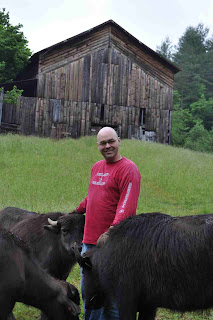Among the most influential of these was FBI Special Agent Dale Cooper, whose exploits in the Inland Empire fighting the forces of darkness were expertly chronicled in the series of dramatic re-creations known as Twin Peaks. A fish out of water in any situation, Special Agent Cooper's strength was his otherness. He understood that no events occur in isolation, that there is no such thing as coincidence, and that you should give yourself a gift every day, even if that gift was just a slice of heavenly pie or a damn fine cup of coffee.
While Special Agent Cooper used his powers of perception to serve humanity, others in his world displayed less nobility. Consider Bob, the hygiene-challenged bête noir who conducted his psychological torture from the inside. Casual fans of the show mistakenly assume that Leland Palmer, father of Laura, was the villain of the piece, but in truth father and daughter were equally victimized (in degree if not in approach). I've long thought that poor, benighted Leland was given a bum rap, and that his image deserved rehabilitation.
Enter Damon Boelte, bar manager at Prime Meats in Brooklyn and creator of the Leland Palmer (http://www.bonappetit.com/recipes/2010/06/the_leland_palmer) . Boelte created this drink as an alcoholic twist on the Arnold Palmer, the classic half-iced-tea and half-lemonade concoction that has soothed hangovers for a generation. Inspired by the scene from Season 2, Episode 8 where a Bob-possessed Leland attempts to brain Special Agent Cooper with a golf club, Boelte clearly intends the Leland Palmer to represent the wicked side of summertime refreshment.
Alison and I stirred up a pitcher for the Memorial Day weekend, looking for an alternative to the G&T or Pimms Cup that typically satisfies our hot-weather boozing. The Leland Palmer rests on a comforting jasmine tea/honey/lemon juice foundation, providing the quiet floral continuity needed to keep the limoncello and gin (we used Bombay Sapphire) from clashing. Mixed with club soda and poured over a generous tower of ice, the resulting drink is extremely mild, with no alcohol burn, and a subtle spice complexity that suggests coastal India.
Sitting on our front porch, watching the storm clouds gather for the afternoon rain, Alison and I finished two glasses apiece, no small feat considering the cup-and-a-half of hooch in the mix. But the demon liquor remained quiet, and we remained headache-free, which cannot be said of every summer cocktail. Maybe if the real Leland was able to keep his demons equally in check, Twin Peaks would have remained a sleepy mountain town, and Special Agent Cooper's Ayurvedic approach to investigation would never have been revealed to the world. So, this summer, raise a glass to old Leland Palmer and his self-sacrifice, so that we could know the secrets of the Black Lodge, the dancing dwarf, and a damn fine reason to serve drinks on the veranda.










